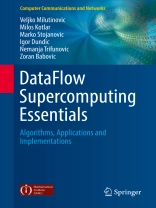This illuminating text/reference reviews the fundamentals of programming for effective Data Flow computing. The Data Flow paradigm enables considerable increases in speed and reductions in power consumption for supercomputing processes, yet the programming model requires a distinctly different approach. The algorithms and examples showcased in this book will help the reader to develop their understanding of the advantages and unique features of this methodology.
This work serves as a companion title to Data Flow Supercomputing Essentials: Research, Development and Education, which analyzes the latest research in this area, and the training resources available.
Topics and features: presents an implementation of Neural Networks using the Data Flow paradigm, as an alternative to the traditional Control Flow approach; discusses a solution to the three-dimensional Poisson equation, using the Fourier method and Data Flow technology; examines how the performance of the Binary Search algorithm can be improved through implementation on a Data Flow architecture; reviews the different way of thinking required to best configure the Data Flow engines for the processing of data in space flowing through the devices; highlights how the Data Flow approach can efficiently support applications in big data analytics, deep learning, and the Internet of Things.
This indispensable volume will benefit all researchers interested in supercomputing in general, and Data Flow computing in particular. Advanced undergraduate and graduate students involved in courses on Data Mining, Microprocessor Systems, and VLSI Systems, will also find the book to be an invaluable resource.
Tabela de Conteúdo
Part I: Algorithms .- Implementing Neural Networks by Using the Data Flow Paradigm.- Part II: Applications .- Solving the Poisson Equation by Using Dataflow Technology.- Binary Search in the Data Flow Paradigm.- Part III: Implementations .- Introductory Overview on Implementation Tools.- Data Flow Systems: From Their Origins to Future Applications in Data Analytics, Deep Learning, and the Internet of Things.












